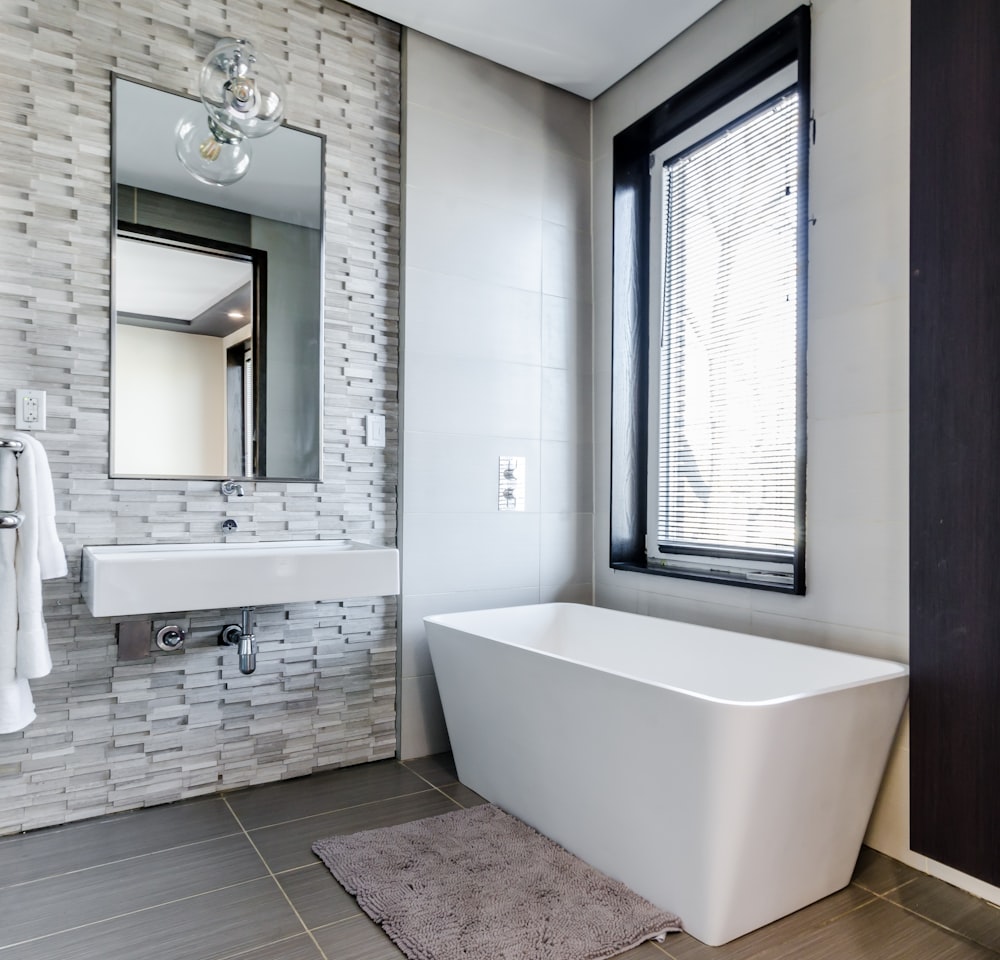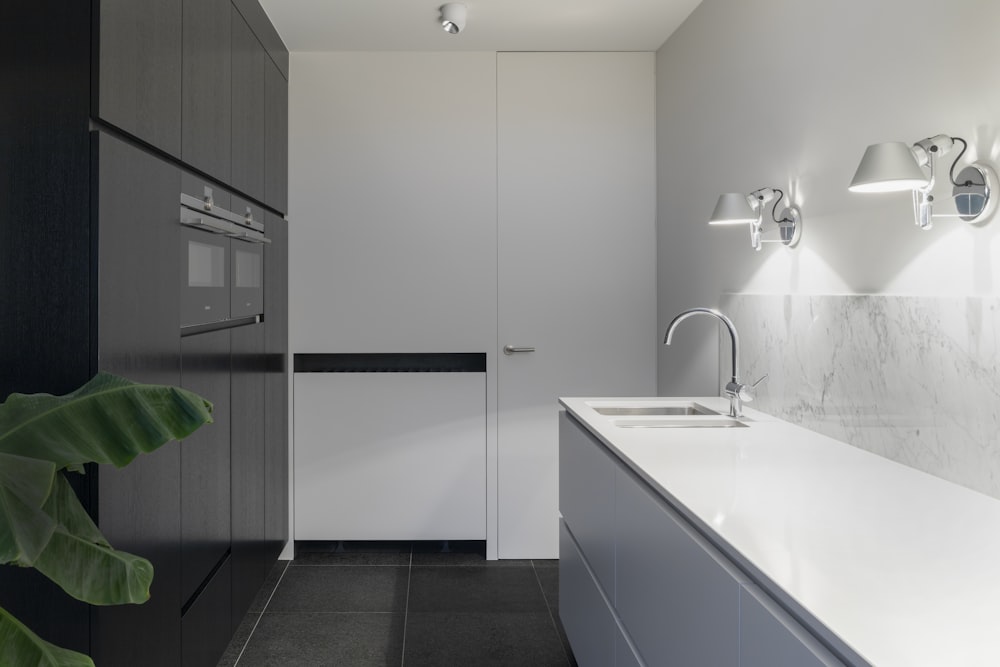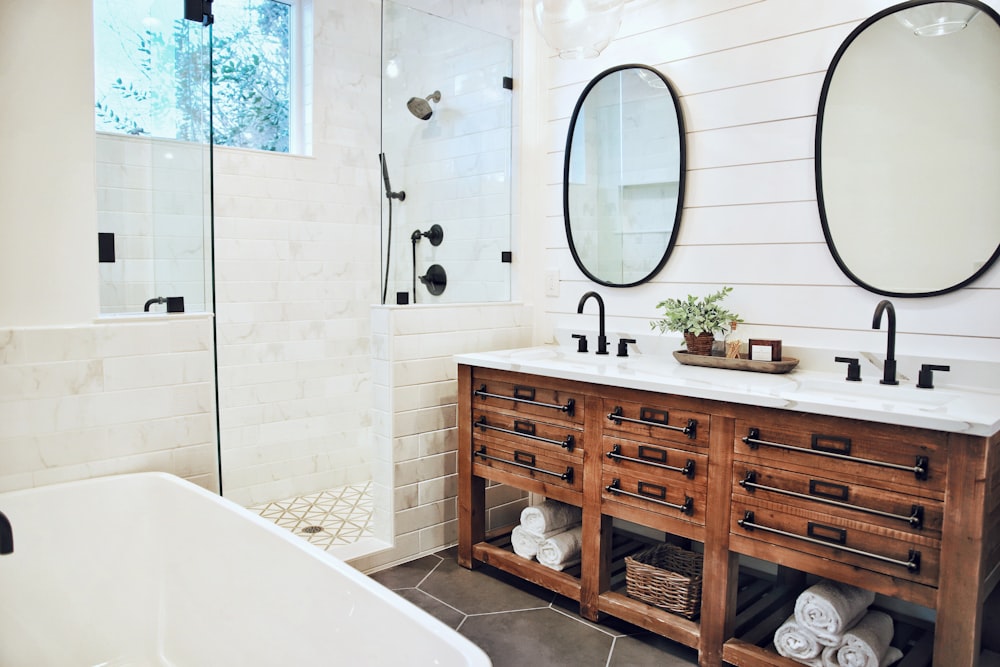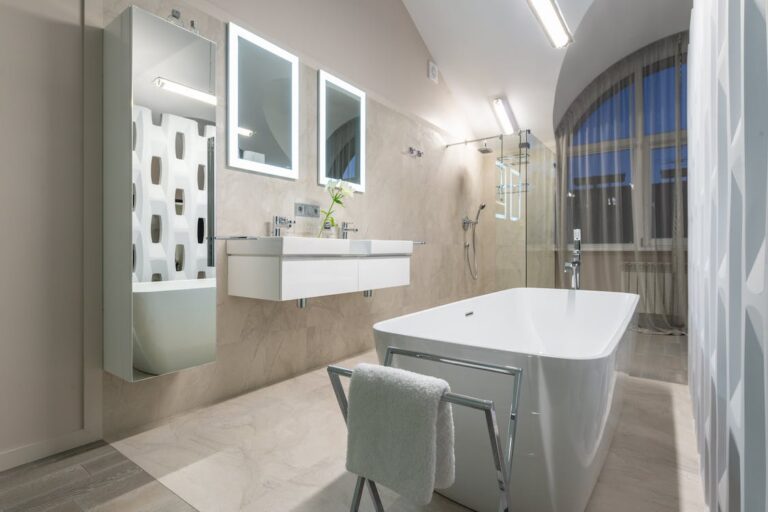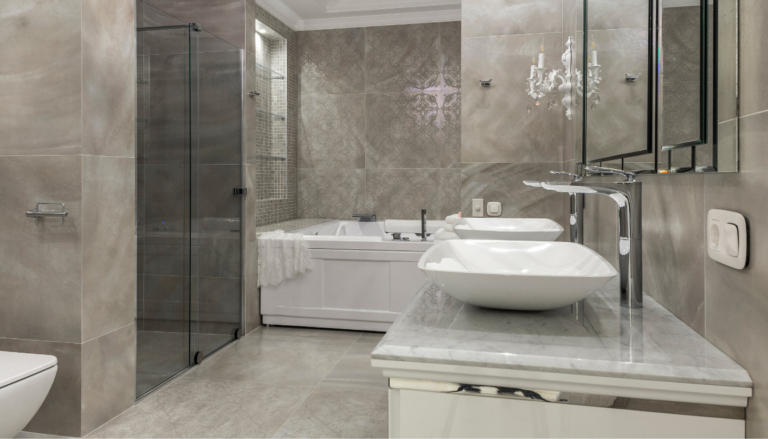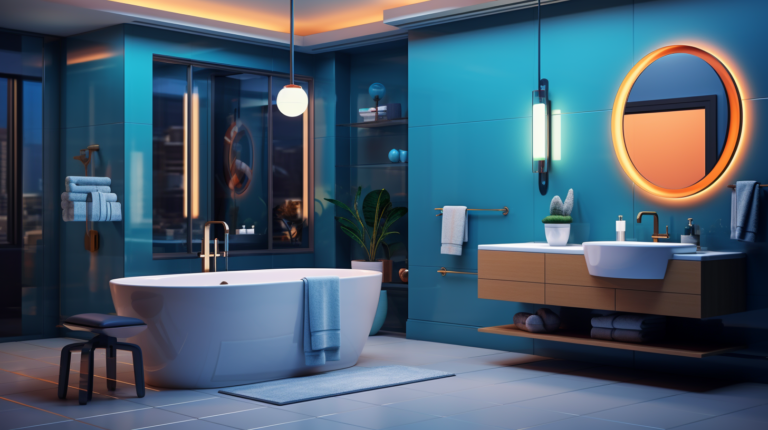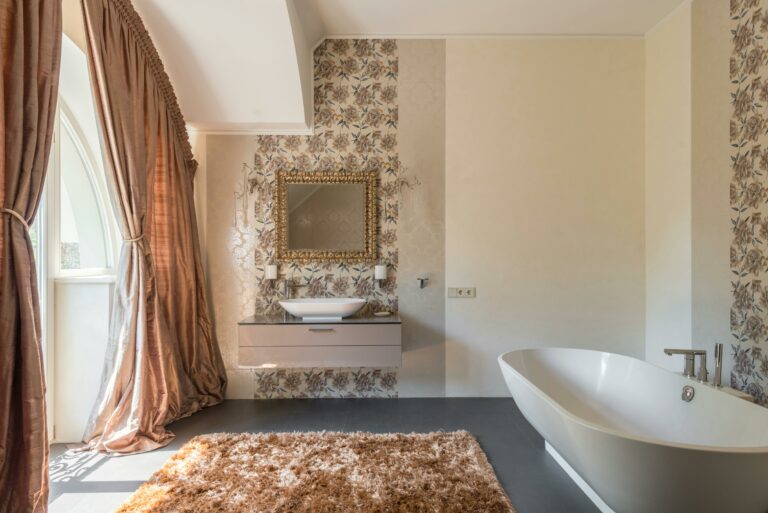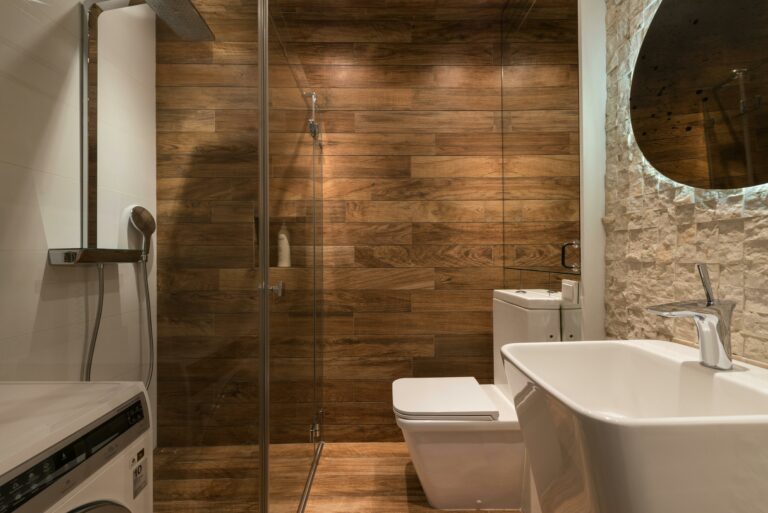Designing Your Dream Bathroom : Tips and Inspiration in 2023
Welcome to the world of bathroom design! Whether you’re planning a full remodel or just looking for some inspiration to spruce up your space, this article is here to guide you. Your bathroom is a sanctuary, a place to start and end your day, and the design should reflect your personal style and needs.
Table of Contents
Designing Your Dream Bathroom
In this article, we will explore various aspects of designing your dream bathroom, including budgeting, planning, execution, color choices, trending materials, smart technology, essential features, accessible design, and sustainable options. By the end, you’ll have a wealth of knowledge and ideas to transform your bathroom into a stunning and functional space.
But before we dive into the details, it’s important to mention that the average cost of a bathroom remodel is around $15,000. Of course, this can vary depending on the size and scope of your project. So, keep your budget in mind as we explore the various stages of bathroom remodeling. Now, let’s get started!
Stages of Bathroom Remodeling
Embarking on a bathroom remodeling project can be both exciting and overwhelming. From budgeting to execution, there are several stages involved in creating your dream bathroom. Whether you want to update your existing bathroom or start from scratch, understanding these stages will help you plan and execute your remodel effectively. So, let’s dive into the stages of bathroom remodeling!
Budgeting: Understanding Costs
Before you start any remodeling project, it’s important to establish a budget. This will help you determine the scope of your project and set realistic expectations. The average cost of a bathroom remodel is $15,000, although it can vary depending on the size and scope of the project.
To create an accurate budget, consider the following expenses:
- Materials: This includes fixtures, tiles, countertops, and cabinets.
- Labor: Hiring professionals for plumbing, electrical work, and installation.
- Permits: Obtaining permits as required by local regulations.
- Unexpected Costs: Leaving some room in your budget for unexpected expenses.
By understanding the costs involved and having a clear budget in mind, you can make informed decisions and avoid overspending.
Planning: Choosing Bathroom Size and Layout
The next stage of bathroom remodeling is planning. This involves determining the size and layout of your bathroom. Consider factors such as:
- Functionality: Think about how you will use the space and what elements are essential to you. Do you want a larger shower or a bathtub? How much storage space do you need?
- Space Constraints: Take into account the existing plumbing and electrical layout, as well as any structural limitations.
- Style and Aesthetics: Consider the overall design and aesthetics that align with your personal taste. Are you going for a modern, minimalist look or a traditional, cozy vibe?
By planning carefully and considering these factors, you can create a bathroom that suits your needs and reflects your style.
Executing: Doing the Remodel
Once you have established your budget and planned your bathroom, it’s time to execute the remodel. This stage involves the actual construction work and installation. Here are a few tips to consider during this stage:
- Hire Professionals: Unless you have experience in plumbing, electrical work, and construction, it’s best to hire professionals for the job. They will ensure the work is done safely and correctly.
- Timelines: Set realistic timelines for the project, taking into account any unexpected delays that may occur.
- Project Management: If you are overseeing the project yourself, make sure to communicate effectively with contractors, suppliers, and any other parties involved.
During the execution stage, it’s important to stay organized, communicate effectively, and keep track of progress to ensure a smooth and successful remodel.
Additional Info: The average cost of a bathroom remodel is $15,000, although it can vary depending on the size and scope of the project.
Designing your dream bathroom involves different stages, from budgeting to execution. By understanding these stages and planning accordingly, you can create a beautiful and functional space that fits your style and needs. So, start envisioning your dream bathroom and get ready to make it a reality!
Choosing Bathroom Colors
When it comes to designing your dream bathroom, choosing the right colors is essential. The color scheme you select can greatly impact the overall look and feel of your bathroom. Here are some tips and inspiration to help you choose the perfect colors for your bathroom:
Go for a Clean and Fresh Look
One popular trend in 2023 is to create a clean and fresh look in the bathroom. The most popular colors for this style are white, gray, and black. These neutral tones create a calming and sophisticated atmosphere, perfect for a spa-like experience in your bathroom.
Experiment with Accent Colors
If you want to add some personality to your bathroom, consider incorporating accent colors. These can be bold and vibrant hues that bring life to the space. You can use accent colors for accessories like towels, rugs, or even a statement wall. Play around with different color combinations to find the one that best suits your taste.
Consider the Size of Your Bathroom
Before selecting your color scheme, take into account the size of your bathroom. Lighter colors, such as pastels or neutrals, can make a small bathroom appear larger and more spacious. On the other hand, darker colors can create a cozy and intimate atmosphere in a larger bathroom.
Use Color Psychology
Color psychology can help you understand how different colors can affect your mood and emotions. Here are a few common color associations for bathroom design:
- Blue: Blue is known for its calming and serene effects. It can create a spa-like ambiance in your bathroom, promoting relaxation and tranquility.
- Green: Green is associated with nature and freshness. It can bring a sense of rejuvenation and peace to your bathroom.
- Yellow: Yellow is a cheerful and energetic color. It can add a burst of positivity and brightness to your bathroom.
- Gray: Gray is versatile and can create a sophisticated and modern look. It pairs well with various accent colors and materials.
Get Inspired by Nature
Nature-inspired color palettes are always a great choice for bathrooms. Consider using earthy tones like beige, brown, and green to bring the outdoors inside. These colors can create a soothing and peaceful environment, perfect for unwinding after a long day.
Remember, choosing the right colors for your bathroom is a personal decision. Take your time to explore different color options and find the combination that resonates with your style and preferences. By selecting the perfect colors, you can create a bathroom that is not only visually pleasing but also a reflection of your personality.
Trending Bathroom Materials
When it comes to designing your dream bathroom, choosing the right materials is crucial. The materials you select can have a significant impact on the overall look and feel of your space. So, if you’re looking for some inspiration, here are the top trending bathroom materials to consider:
1. Natural materials
Natural materials like marble, stone, and wood are making a big comeback in bathroom design. These materials add a touch of elegance, texture, and warmth to any space. Here are some popular options:
- Marble: Known for its luxurious appearance, marble is a timeless choice for bathroom countertops, floors, and even shower walls. It comes in a variety of colors and patterns, allowing you to create a unique and sophisticated look.
- Stone: Natural stone, such as slate or travertine, can add a rustic and earthy charm to your bathroom. It works well for wall cladding, flooring, and even sinks.
- Wood: Incorporating wood elements in your bathroom design can bring a sense of warmth and serenity. Consider using wooden vanities, shelving, or accents to create a spa-like atmosphere.
2. Concrete
Concrete has been gaining popularity in recent years due to its sleek and modern appearance. It’s versatile and can be used for countertops, sinks, and even shower walls. With its smooth and durable surface, concrete adds an industrial edge to your bathroom design.
3. Glass
For a contemporary and airy feel, consider incorporating glass into your bathroom design. Glass shower enclosures, mirrors, and even countertops can create a sense of openness and light. Additionally, glass mosaic tiles are a popular choice for adding a pop of color and texture to your bathroom walls or backsplash.
4. Porcelain and Ceramic Tiles
Porcelain and ceramic tiles are classic choices for bathroom flooring and walls. They come in a wide range of styles, colors, and patterns, making it easy to find the perfect match for your design aesthetic. Additionally, these materials are water-resistant and easy to clean, making them practical choices for bathrooms.
5. Metal Accents
Metal accents, such as brass, copper, or gold, can add a touch of glamour and sophistication to your bathroom. Consider incorporating metal finishes in your faucets, showerheads, and hardware to create a focal point and elevate the overall design.
Whether you prefer a natural and organic feel or a sleek and modern look, these trending bathroom materials can help you create a space that reflects your style and personality. Remember to consider factors like durability, maintenance, and cost when making your selection.
“Choosing the right materials can transform your bathroom into a luxurious and functional space. Consider the trending materials mentioned above to create a bathroom that is both stylish and practical.”
Smart Bathroom Technology
Gone are the days when bathrooms were only functional spaces. With the advent of technology, bathrooms have become high-tech havens for relaxation and convenience. From touchless faucets to voice-activated toilets, smart bathroom technology is revolutionizing the way we experience this important part of our homes. In this section, we’ll explore some of the latest smart bathroom technologies and how they can enhance your daily routine.
Touchless Faucets
One of the most popular innovations in smart bathroom technology is touchless faucets. These faucets use motion sensors to detect when you want to turn the water on or off, eliminating the need to touch the handle with dirty hands. Not only are touchless faucets more hygienic, but they also help conserve water by automatically shutting off after a certain period of inactivity. With touchless faucets, you can enjoy a hands-free and eco-friendly bathroom experience.
Voice-activated Toilets
Imagine walking into your bathroom and simply saying, “Flush.” With voice-activated toilets, this is no longer a fantasy. These futuristic toilets respond to voice commands, allowing you to control functions like flushing, seat warming, and bidet features with just your voice. Voice-activated toilets also come equipped with sensors that automatically open and close the lid, providing a touchless and convenient experience. With these smart toilets, using the bathroom becomes a breeze.
Smart bathroom technology offers a range of benefits. Here are a few reasons why you might consider incorporating smart technology into your bathroom design:
- Convenience: With smart bathroom technology, you can automate various tasks and save time and effort in your daily routine.
- Hygiene: Touchless faucets and voice-activated toilets reduce the spread of germs and promote better hygiene.
- Energy Efficiency: Many smart bathroom technologies are designed to be energy-efficient, helping to reduce your environmental footprint.
- Modern Aesthetics: Smart bathroom fixtures have sleek and modern designs that can enhance the overall look and feel of your bathroom.
Keep in mind that incorporating smart technology into your bathroom may require some additional planning and installation. Here are a few tips to help you navigate the process:
- Research: Take the time to research different smart bathroom technologies and choose the ones that suit your needs and preferences.
- Compatibility: Ensure that the smart devices you choose are compatible with the existing plumbing and electrical systems in your bathroom.
- Installation: Consult with professionals to ensure proper installation of smart devices, as they may require specialized knowledge.
- Maintenance: Stay informed about software updates and maintenance requirements for your smart bathroom technology to ensure optimal performance.
In the age of smart homes, it’s no surprise that bathrooms are getting a high-tech makeover. With touchless faucets, voice-activated toilets, and other smart bathroom technologies, you can transform your bathroom into a modern and convenient space. Embrace the future and elevate your daily routine with these exciting advancements in bathroom design.
Also Read: Transform Your Bathroom : Tips for a Stunning Renovation in 2023
Essential Bathroom Features
When designing your dream bathroom, it’s important to consider the essential features that will enhance both the functionality and aesthetics of the space. From proper lighting to adequate storage, these features play a crucial role in creating a bathroom that meets all your needs. Here are some essential bathroom features to keep in mind:
Adequate Storage
One of the key considerations in bathroom design is ensuring that you have enough storage space for all your toiletries, towels, and other essentials. No one wants a cluttered bathroom with items strewn about. Here are some storage solutions to consider:
- Vanity cabinets: These are a popular choice for storing toiletries and cleaning supplies. They come in various sizes and styles to match your bathroom decor.
- Shelves and niches: Installing shelves or niches in the shower area can provide a convenient spot for shampoo, conditioner, and soap.
- Hooks and towel bars: These are great for hanging towels and robes, keeping them within easy reach.
- Medicine cabinets: If you have medications or small items that need to be kept away from moisture or children, a medicine cabinet is a practical choice.
Proper Lighting
Lighting is a vital aspect of bathroom design, as it sets the mood and ensures you have enough visibility for grooming tasks. Here are some lighting options to consider:
- Natural light: If possible, maximize natural light by adding windows or skylights to your bathroom. This not only brightens the space but also provides a sense of openness.
- Task lighting: Install task lighting near the mirror to ensure proper illumination for activities like shaving or applying makeup. Wall sconces or LED light strips are good options.
- Ambient lighting: Consider installing recessed lighting or a chandelier to provide overall illumination in the bathroom. This can create a warm and inviting atmosphere.
- Dimmer switches: Including dimmer switches in your bathroom allows you to adjust the lighting level according to your needs and preferences.
Ventilation
Proper ventilation is essential in a bathroom to remove moisture, prevent mold and mildew growth, and maintain good air quality. Here are some ventilation options to consider:
- Exhaust fans: Install an exhaust fan that is specifically designed for bathrooms. This helps remove steam, odors, and moisture from the air after showering or bathing.
- Windows: If your bathroom has windows, make sure they can be opened to allow fresh air to circulate. This can help keep the space well-ventilated.
- Proper insulation: Ensure that your bathroom is properly insulated to prevent condensation on surfaces and maintain the right humidity level.
Remember, a combination of natural and artificial light, along with proper ventilation, can make your bathroom a comfortable and inviting space.
Mentioning the importance of essential bathroom features conveys to the reader the significance of considering these aspects in their bathroom design. Additionally, by providing specific suggestions and tips, the article offers valuable information that can guide readers in making informed decisions about their bathroom remodeling or design projects.
Accessible Bathroom Design
Ensuring that your bathroom is accessible is not only important for those with mobility challenges but also for creating a space that can be used by everyone. Accessible bathroom design focuses on making the bathroom safe, comfortable, and convenient for individuals with disabilities. If you’re considering creating an accessible bathroom, here are some key features to keep in mind:
Grab Bars
Grab bars are crucial for providing stability and support for individuals with mobility issues. They can be installed near toilets, showers, and bathtubs to help with balance and prevent falls. When choosing grab bars, make sure they are sturdy, properly installed, and able to support the weight of the user. It’s also essential to position them at the right height and in locations that are easily accessible.
Roll-in Showers
Roll-in showers are another important feature for accessible bathrooms. These showers have no curb or step, allowing individuals in wheelchairs to easily enter and exit the shower area. Additionally, roll-in showers should have grab bars, a handheld showerhead, and a sturdy bench or seat for added convenience and safety.
Wide Doorways and Clear Floor Space
To accommodate wheelchairs and walkers, it’s crucial to design your accessible bathroom with wide doorways and clear floor space. The recommended minimum width for a wheelchair-accessible doorway is 36 inches. Similarly, the bathroom should have enough open space to allow for maneuverability, especially around fixtures like sinks, toilets, and showers.
Non-Slip Flooring
Having non-slip flooring in an accessible bathroom is essential for preventing slips and falls. Choose flooring materials that provide good traction, such as textured tiles or vinyl. It’s also important to ensure that the flooring is level and free from obstacles that may cause tripping hazards.
Adjustable Fixtures and Heights
Consider installing fixtures and features that can be adjusted to accommodate different user height and reach. For example, choose a toilet with adjustable seat height or install a sink with a lever handle faucet that can be easily operated by individuals with limited dexterity. Adjustable fixtures can make the bathroom more accessible and comfortable for users of varying abilities.
Accessible Storage
In an accessible bathroom, it’s important to have storage options that are easily reachable for individuals with disabilities. Install lower cabinets or open shelving that allows users to access bathroom essentials without stretching or bending down. Additionally, consider installing wall-mounted or adjustable-height mirrors that can be tilted for better visibility.
Designing an accessible bathroom is not only about meeting functional needs but also about creating an inclusive and welcoming space for all. By incorporating these features into your bathroom design, you can ensure that your bathroom is accessible, safe, and comfortable for everyone who uses it.
Remember, an accessible bathroom design is all about making the space convenient for users with disabilities while maintaining an aesthetically pleasing and functional environment for all.
Sustainable Bathroom Design
In recent years, sustainability has become a key consideration in home design. People are more conscious of their impact on the environment and are seeking ways to make their homes more eco-friendly. One area where sustainable design is gaining traction is in the bathroom. With a few simple changes, you can create a bathroom that is both beautiful and sustainable. In this article, we will explore some tips and ideas for designing a sustainable bathroom.
Energy-efficient Fixtures
One of the best ways to make your bathroom more sustainable is by using energy-efficient fixtures. These fixtures are designed to minimize water and energy consumption, helping to reduce your carbon footprint. Here are a few examples of energy-efficient fixtures that you can incorporate into your bathroom design:
- Low-flow showerheads: These showerheads use less water without sacrificing water pressure, allowing you to enjoy a refreshing shower while conserving water.
- Dual-flush toilets: Dual-flush toilets give you the option to use a lower volume of water for liquid waste and a higher volume for solid waste, reducing water usage.
- LED lighting: LED lights are highly energy-efficient and have a longer lifespan compared to traditional incandescent bulbs. Consider installing LED light fixtures or bulbs in your bathroom to save energy and reduce the need for frequent bulb replacements.
Water-saving Appliances
Aside from energy-efficient fixtures, you can also opt for water-saving appliances in your bathroom. These appliances are designed to operate with minimal water usage, reducing both your water bill and your environmental impact. Here are some examples of water-saving appliances you can choose for your bathroom:
- Water-saving faucets: Faucets with aerators reduce the flow of water while maintaining sufficient water pressure. This helps conserve water without compromising functionality.
- Tankless water heaters: Tankless water heaters are more energy-efficient than traditional storage tank water heaters. They heat water on demand, eliminating the standby energy loss associated with heating and maintaining a large tank of water.
Using Sustainable Materials
In addition to energy-efficient fixtures and appliances, using sustainable materials in your bathroom design is another way to make your space more eco-friendly. Consider incorporating the following materials into your bathroom:
- Recycled materials: Look for products made from recycled materials, such as recycled glass countertops or tiles made from recycled porcelain.
- Bamboo: Bamboo is a fast-growing and renewable resource that can be used for bathroom flooring, cabinets, and accessories. It is a sustainable alternative to traditional hardwood.
- Natural stone: Natural stone, such as granite or marble, is a durable and long-lasting material that adds a touch of elegance to any bathroom. Just make sure to choose stone that is responsibly sourced to ensure its sustainability.
By using energy-efficient fixtures, water-saving appliances, and sustainable materials, you can create a bathroom that not only looks beautiful but also contributes to a more sustainable future. Small changes and conscious choices can go a long way in reducing your environmental impact. So why not start designing your dream sustainable bathroom today?
“Creating a sustainable bathroom is not only beneficial for the environment but also for your wallet in the long run. By reducing your energy and water consumption, you can save on utility bills while making a positive impact on the planet.”
Also Read: Budget-Friendly Bathroom Renovation Ideas for Homeowners in 2023
Conclusion
In conclusion, designing your dream bathroom involves careful planning, consideration of various factors, and staying up to date with the latest trends and technologies. Here are some key takeaways from this article:
- Stages of Bathroom Remodeling: Budgeting, planning, and executing the remodel are the three main stages to consider.
- Choosing Bathroom Colors: The most popular colors for bathrooms in 2023 are white, gray, and black. These colors create a clean and modern look.
- Trending Bathroom Materials: Natural materials like marble, stone, and wood are currently trending in bathroom design. They bring a touch of luxury and warmth to any space.
- Smart Bathroom Technology: Smart bathroom technology, such as touchless faucets and voice-activated toilets, can add convenience and efficiency to your daily routine.
- Essential Bathroom Features: Adequate storage, proper lighting, and ventilation are crucial for a functional and comfortable bathroom.
- Accessible Bathroom Design: It’s important to consider accessibility when designing a bathroom. Features like grab bars and roll-in showers can enhance safety and usability for people of all abilities.
- Sustainable Bathroom Design: Creating an eco-friendly bathroom with energy-efficient fixtures and water-saving appliances is not only trendy but also helps to conserve resources and reduce utility costs.
By incorporating these tips and inspiration into your bathroom design, you can create a space that reflects your style, meets your needs, and adds value to your home.
Remember, the journey to designing your dream bathroom should be enjoyable and stress-free. Take your time, do your research, and consult with professionals when needed. Your dream bathroom is just a few steps away!
Keep exploring Arkitecture Today’s blog for more exciting articles on architecture, home, interior design, decoration ideas, and inspiration. Visit Arkitecture Today to stay up to date with the latest trends and design tips.
Frequently Asked Questions
- What are some popular bathroom design trends?Some popular bathroom design trends include minimalist designs, natural materials, large walk-in showers, freestanding tubs, and smart technology integration.
- How can I make my small bathroom look more spacious?To make a small bathroom look more spacious, consider using lighter colors, installing a large mirror, opting for a floating vanity, utilizing built-in storage solutions, and maximizing natural light.
- What are some essential fixtures and fittings for a well-designed bathroom?Some essential fixtures and fittings for a well-designed bathroom include a high-quality toilet, a functional and stylish sink, a shower or bathtub that suits your needs, good lighting, and adequate storage space.
- What are the benefits of hiring a professional bathroom designer?Hiring a professional bathroom designer can provide numerous benefits, such as expertise in space planning, knowledge of the latest design trends, access to a wide range of materials and fixtures, and the ability to create a cohesive and visually appealing design.
- How can I create a spa-like atmosphere in my bathroom?To create a spa-like atmosphere in your bathroom, consider incorporating elements such as a luxurious bathtub, soft lighting, plants, calming colors, scented candles or essential oils, and plush towels and bathrobes.



